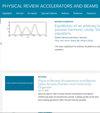Simple modification of Compton polarimeter to redirect synchrotron radiation
Physical Review Special Topics-accelerators and Beams
Pub Date : 2015-11-30
DOI:10.1103/PHYSREVSTAB.18.112401
引用次数: 1
Abstract
Synchrotron radiation produced as an electron beam passes through a bending magnet is a significant source of background in many experiments. Using modeling, we show that simple modifications of the magnet geometry can reduce this background by orders of magnitude in some circumstances. Specifically, we examine possible modifications of the four dipole magnets used in Jefferson Lab’s Hall A Compton polarimeter chicane. This Compton polarimeter has been a crucial part of experiments with polarized beams and the next generation of experiments will utilize increased beam energies, up to 11 GeV, requiring a corresponding increase in Compton dipole field to 1.5 T. In consequence, the synchrotron radiation (SR) from the dipole chicane will be greatly increased. Three possible modifications of the chicane dipoles are studied; each design moves about 2% of the integrated bending field to provide a gentle bend in critical regions along the beam trajectory which, in turn, greatly reduces the synchrotron radiation within the acceptance of the Compton polarimeter photon detector. Each of the modifications studied also softens the SR energy spectrum at the detector sufficiently to allow shielding with 5 mm of lead. Simulations show that these designs are each capable of reducing the background signal duemore » to SR by three orders of magnitude. The three designs considered vary in their need for vacuum vessel changes and in their effectiveness.« less简单修改康普顿偏振计,重定向同步辐射
电子束通过弯曲磁体时产生的同步辐射是许多实验中重要的背景源。通过建模,我们表明,在某些情况下,磁铁几何形状的简单修改可以将该背景降低几个数量级。具体地说,我们研究了杰斐逊实验室A厅康普顿极化计中使用的四个偶极磁体的可能修改。康普顿偏振计是偏振光束实验的重要组成部分,下一代实验将利用更高的光束能量,最高可达11 GeV,需要将康普顿偶极子场相应提高到1.5 t。因此,来自偶极子通道的同步辐射(SR)将大大增加。研究了chicane偶极子的三种可能的修正;每个设计移动约2%的集成弯曲场,在沿光束轨迹的关键区域提供温和的弯曲,这反过来又大大减少了康普顿偏振光子探测器可接受的同步辐射。所研究的每一种修改也软化了探测器处的SR能谱,足以允许用5毫米的铅屏蔽。仿真结果表明,这两种设计都能将背景信号降噪到SR降低三个数量级。考虑的三种设计在他们需要真空容器的变化和他们的有效性。«少
本文章由计算机程序翻译,如有差异,请以英文原文为准。
求助全文
约1分钟内获得全文
求助全文
来源期刊
自引率
0.00%
发文量
0
审稿时长
3-8 weeks
期刊介绍:
Physical Review Special Topics - Accelerators and Beams (PRST-AB), is a peer reviewed, purely electronic journal, distributed without charge to readers and funded by contributions from national laboratories. It covers the full range of accelerator science and technology: subsystem and component technologies, beam dynamics; accelerator applications; and design, operation, and improvement of accelerators used in science and industry. This includes accelerators for high-energy and nuclear physics, synchrotron radiation production, spallation neutron sources, medical therapy, and intense beam applications.

 求助内容:
求助内容: 应助结果提醒方式:
应助结果提醒方式:


